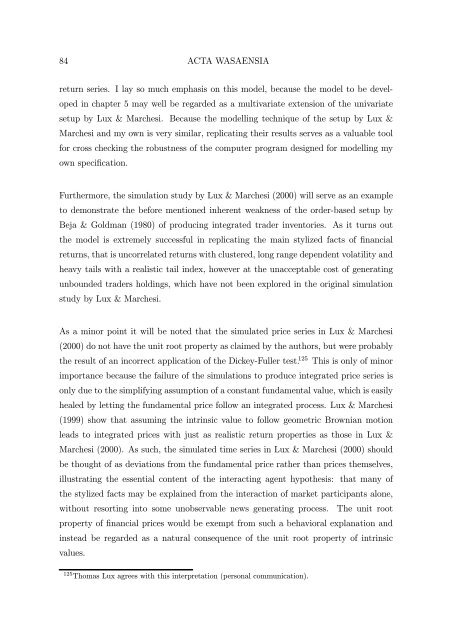BERND PAPE Asset Allocation, Multivariate Position Based Trading ...
BERND PAPE Asset Allocation, Multivariate Position Based Trading ...
BERND PAPE Asset Allocation, Multivariate Position Based Trading ...
Create successful ePaper yourself
Turn your PDF publications into a flip-book with our unique Google optimized e-Paper software.
84 ACTA WASAENSIAreturn series. I lay so much emphasis on this model, because the model to be developedin chapter 5 may well be regarded as a multivariate extension of the univariatesetup by Lux & Marchesi. Because the modelling technique of the setup by Lux &Marchesi and my own is very similar, replicating their results serves as a valuable toolfor cross checking the robustness of the computer program designed for modelling myown specification.Furthermore, the simulation study by Lux & Marchesi (2000) will serve as an exampleto demonstrate the before mentioned inherent weakness of the order-based setup byBeja & Goldman (1980) of producing integrated trader inventories. As it turns outthe model is extremely successful in replicating the main stylized facts of financialreturns, that is uncorrelated returns with clustered, long range dependent volatility andheavy tails with a realistic tail index, however at the unacceptable cost of generatingunbounded traders holdings, which have not been explored in the original simulationstudybyLux&Marchesi.As a minor point it will be noted that the simulated price series in Lux & Marchesi(2000) do not have the unit root property as claimed by the authors, but were probablythe result of an incorrect application of the Dickey-Fuller test. 125 This is only of minorimportance because the failure of the simulations to produce integrated price series isonly due to the simplifying assumption of a constant fundamental value, which is easilyhealed by letting the fundamental price follow an integrated process. Lux & Marchesi(1999) show that assuming the intrinsic value to follow geometric Brownian motionleads to integrated prices with just as realistic return properties as those in Lux &Marchesi (2000). As such, the simulated time series in Lux & Marchesi (2000) shouldbe thought of as deviations from the fundamental price rather than prices themselves,illustrating the essential content of the interacting agent hypothesis: that many ofthe stylized facts may be explained from the interaction of market participants alone,without resorting into some unobservable news generating process. The unit rootproperty of financial prices would be exempt from such a behavioral explanation andinstead be regarded as a natural consequence of the unit root property of intrinsicvalues.125 Thomas Lux agrees with this interpretation (personal communication).
















